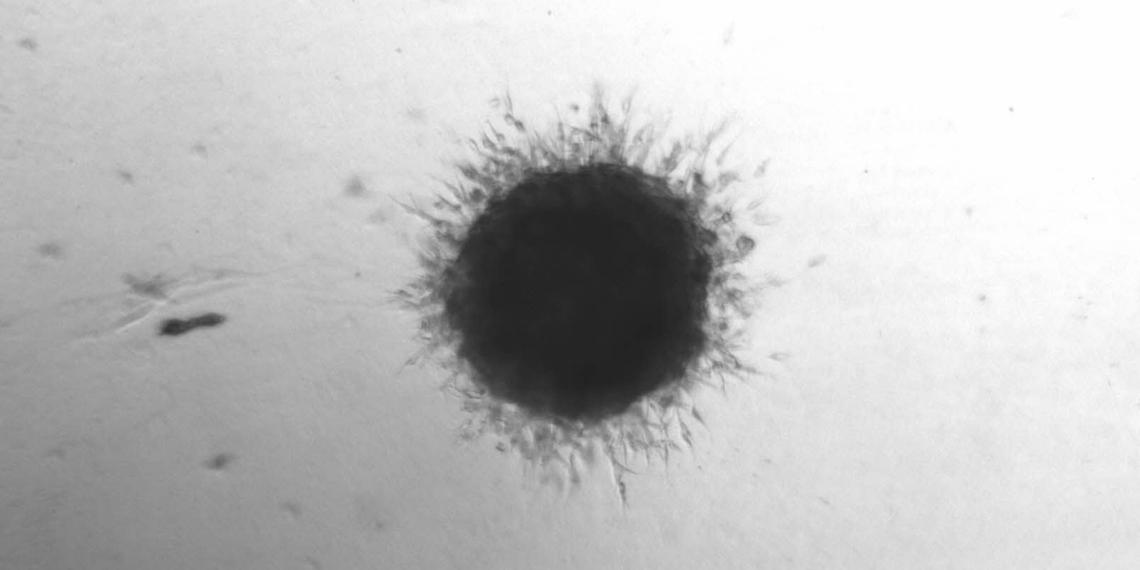Taking a ‘Three-Dimensional Approach’ to Cancer Research Yields New Insight

Tumours create extremely hostile environments within the human body. As they grow, they outpace the blood supply, resulting in a core with little to no oxygen, increased acidity, and a lack of nutrients. How is it that cancer cells can not only survive but thrive within these harsh conditions?
 Cancer cells have a remarkable ability to adapt to conditions of stress. It’s a biological phenomenon that is of key interest to cancer researcher Dr. Jim Uniacke in the Department of Molecular and Cellular Biology.
Cancer cells have a remarkable ability to adapt to conditions of stress. It’s a biological phenomenon that is of key interest to cancer researcher Dr. Jim Uniacke in the Department of Molecular and Cellular Biology.
By growing cancer cells in the form of mini three-dimensional (3D) tumours, Uniacke and his team recently homed in on a key response to stress that helps explain how cancer cells can thrive in low oxygen.
“Cells in a two-dimensional space — which is how cells have traditionally been cultured in the lab — are not as physiologically representative. Human cells exist in a three-dimensional environment, so it is important to understand how cancer cells function in a three-dimensional space,” explains Uniacke.
Uniacke’s particular focus is on gene expression from ribosomes, which are the cell's protein factories, and how this expression shifts in response to different types of stress, such as low oxygen or “hypoxia.”
In a process known as “alternative splicing,” cells have a way of making different versions of proteins from the same genetic instructions, like cutting and pasting words from a sentence to create a new meaning. In earlier work, Uniacke’s team discovered that when exposed to hypoxia, cells began to produce a variant of a protein called “RPS24” that is an important part of the ribosome machinery. The variant, known as RPS24L, is longer in length than the normal RPS24 protein and is considered a more stable form.
In a more recent study, Uniacke and his team examined RPS24L's response to stress conditions by growing cell clusters into three-dimensional structures called “spheroids” that more closely mimic the environment found in tumours.
They then tested the spheroids for the RPS24L variant under low oxygen conditions and found that levels of the protein were several times higher within the spheroid models compared to the two-dimensional cell models. This effect was observed across three different types of cancer cells, including glioblastoma, colorectal carcinoma, and prostate cancer.
Initially, the team believed this difference might be due to the combination of acidity, nutrient stress, and low oxygen that is inherently present in spheroids. But, when they ensured that all these same stress factors were applied to the 2D cell model, the effect on RPS24L levels wasn't as strong as in the 3D spheroids – highlighting the importance of a tissue’s “spatial architecture” in cancer biology.
Importantly, the team also showed that spheroids producing the RPS24L variant also led to greater cell survival and growth during hypoxia relative to spheroids producing the normal RPS24 protein.
This is why getting as close to a “physiological setting” is crucial in cancer research – and Uniacke notes that spheroids are only just the beginning. “A spheroid is a single cell type, but a real tumour has many different cell types in it.”
The next step towards real-world accuracy in tumour models is an organoid model. These “mini organ” models contain a variety of cell types that allow you to see how cell and tissue function differ when various cells interact with each other and the environment.
The lab’s discovery of the role of RPS24L in response to low oxygen stress is a step forward not only in our understanding of basic cell function, but also in our understanding of how cancer can defy the odds.
“We are learning something new about fundamental biology and how human disease is exploiting this basic cell biology function to its advantage,” says Uniacke
Supporting molecular and cellular science is as crucial as ever. Life-changing innovations like mRNA vaccines and CRISPR began with incremental developments, with no way of knowing how wide-reaching and impactful these discoveries would someday be. The same type of foundational research can lead to new transformative applications in cancer treatment and beyond.
“Funding basic research, without question, will yield these applications,” says Dr. Uniacke. “We are discovering new things about how life works, and it will have important applications.”
Read the full study in the Federation of European Biochemical Societies (FEBS) Letters.
Read about other CBS Research Highlights.